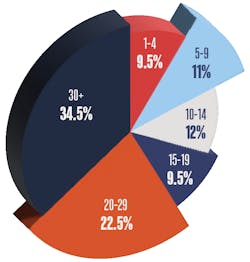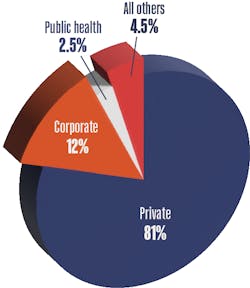The state of the RDH career: the results are in!
From late July through early September 2021, DentalPost and the Endeavor Business Media Dental Group, including RDH magazine, partnered to conduct the largest and most comprehensive dental professional salary survey of its kind. From compensation to work environments and job turnover rates, here are some of the latest numbers and insights from responding hygienists.
Audience profile
Consisting of responses from 13,036 dental professionals, including 6,042 hygienists, the 2021 salary survey included 69 questions and was designed, analyzed, and reported by DentalPost.
57% of respondents had 20-plus years of experience. 1 in 5 had 10–20 years of experience. 1 in 4 had fewer than 10 years. of experience.
Years of experience: 57% had 20+
81% work in private practices
The vast majority of survey respondents work in private practices, with 12% reporting they work in corporate practices, 2.5% in public health, and 4.5% in all other types of clinical employment.
The number of young RDHs in corporate practices grew. 75% of hygienists younger than 25 years of age work in private practices. 19% work in corporate practices. This is up a full 10% since last year’s survey.
Type of practice:
75% of hygienists under the age of 25 work in private practices
How they work
Most hygienists identify as full time (64%), with the remaining as part time (36%). Being an RDH means more than being full time or part time; often it means deciding between one job or multiple jobs. 10% of this year’s respondents reported they work in more than one dental office. Another 10% reported they work nonclinical side jobs in the gig economy.
64% work full time
A much greater percentage of private practice RDHs work part time than in corporate dental environments. In fact, a hygienist in private practice is two times more likely to be a part-time worker than hygienists in corporate practices. Over 60% of respondents indicated they are satisfied with their hours.
74% see 7 to 9 patients per day
In private practices 87% of RDHs spend 40 minutes or more per patient. In corporate practices, 76% spend 40 minutes or more per patient.
Temping: Increasingly appealing
Due to the RDH shortage, dental hygienists nationwide are increasingly being recruited to work temp jobs, and they are being offered higher wages to do so. Based on anecdotal commentary from the salary survey, a growing number of hygienists say they are supplementing their primary income with added temp work, with some even transitioning to full-time temp roles.
In addition to earning higher hourly wages, some dental hygienists prefer working temp jobs because they can focus on the work and stay out of the day-to-day of office responsibilities, including the “drama” that can come with it. Some mentioned that adapting to different software platforms was a challenge at times. But overall, they prefer temping because it gives them more flexibility to balance family life (particularly those with school-aged children), less stress and drama, and more appreciation from those who hire them.
92% are paid their full rate for no shows and open hours
How they are paid
In both private and corporate practices, over 84% of dental hygienists are paid hourly, and over 90% are paid their full rate for no-shows and open hours during the middle of the day.
The average reported hourly wage of survey respondents was $38. 72% of the respondents working full time reported total annual income from their clinical practice ranging from $40,000 to $80,000. The average varied by type of practice, location, and years of experience.
Year over year, the number of dental hygienists in the $80,000-plus income bracket has increased. This year’s survey indicates a 6% increase in the last year.
Average income by type of practice
- Community health: $79,224
- Hospital: $71,690
- Corporate: $73,630
- Public health: $71,748
- Private practice: $68,861
- Prison: $66,917
- University: $64,133
- Mobile clinic: $59,333
The impact of location
Among our respondents, the highest average incomes are equal to or greater than $80,000. They occur in these six locations:
- Washington D.C.
- Alaska
- California
- Washington
- Maryland
- Nevada
The lowest average incomes are less than $60,000 and occur in these seven states with Alabama averaging the least at $46,300:
- Rhode Island
- Pennsylvania
- Michigan
- Kentucky
- Mississippi
- Wyoming
- Alabama
Cost of living is a key factor that should be taken into consideration in looking at the “highest” and “lowest” paying states. Using an online cost of living adjustment calculator, one can shed light into the salary a dental hygienist would need to earn in a particular city to maintain or improve their current standard of living.
For example, using a cost-of-living adjustment calculator reveals that the current cost of living in top-paying Washington, DC, is 63.5% higher than in Mobile, Alabama. If a hygienist is contemplating a move from Mobile to Washington, DC, and currently earning the Alabama state average of $46,300, they would need a new income of $75,716 to maintain a standard of living. The average income of RDH survey respondents in Washington, DC, is $109,750, which means a move to DC would likely provide significantly greater disposable income.
Boost your career!
7 strategies to strengthen your employment opportunities
The hygiene department: A business within the business
Bonuses
Nearly 35% of RDHs earn bonuses. 56% of bonuses are based on overhead with the majority of these bonuses paid monthly or annually. Nearly 75% of those who receive bonuses anticipated they would receive less than $5,000 in total bonuses in 2021.
Raises and income satisfaction
Over 40% of RDHs reported receiving a raise within the last 12 months. 62% received a raise within the last 24 months, and 72% are satisfied with their income. Among those whose 2021 income is less than $50,000, 36% are dissatisfied with their income. Only 5.5% of all respondents said they are “very dissatisfied” with their income.
72% of RDHs are satisfied with their income
Comparing year-over-year results, the number of RDHs who were “satisfied” or “very satisfied” with their income rose by 10% this year compared with 2020.
Benefits
Beyond compensation, employee benefits are important among RDHs. In fact, 77.5% reported benefits are “very” to “extremely” important. This year, we asked specifically which benefits they receive.
In corporate dental practices, a striking 63.5% of RDHs reported they receive health insurance compared to 22.5% of RDHs in private practices.
The top seven benefits
Only 33% of RDHs receive CE tuition reimbursement
- Paid holidays and vacations: 72%
- Retirement plan/401(k): 57%
- Low-cost dental benefits for self: 53%
- Low-cost dental benefits for family: 48%
- Uniforms provided: 46%
- Paid sick days: 44%
- CE tuition reimbursements: 33%
Job hunting and recent turnover
Only three RDHs out of 6,040 reported they were unemployed at the time of response. Two were seeking employment. One just recently retired. Zero reported they were planning to switch careers.
Just under 30% of all RDHs said they interviewed for one or more new jobs within the last year. 34% changed employers within the last two years, 17.5% within the last year.
14% of all RDHs said they planned to look for a new job within the next year, while 18% reported they were unsure whether they would seek a new job in the next year. This is noteworthy given that in our previous survey one year ago, 43% said they planned to seek a new job in the next year.
14% plan to seek a new job within the next year
Retirement outlook
In the next decade, nearly half of all RDHs plan to retire. Just under 60% of these are age 55 and up.
Takeaways
Our survey tells a story of rising wages and increased income satisfaction this year over last year.
In 2020, 75% of the full-time dental hygienist salaries ranged from $40,000 to $80,000, with 33.5% of RDHs earning $70,000+ annually and 15.5% earning over $80,000+ annually.
In 2021, 72% of full-time dental hygienist salaries ranged from $40,000 to $80,000 with 43% of RDHs earning $70,000 or more annually and 21% of RDHs earning $80,000 or more annually.
Satisfaction is up 30% since last year’s survey. Among those who indicated they are dissatisfied with their income, the median income is $64,000, indicating that it is not just the lowest paid dental hygienists who are dissatisfied with their income.
None of our 6,000+ RDH respondents indicated they were thinking of leaving their profession, but with 14% intending to seek a new hygiene position in the next year, combined with the ongoing shortage of hygienists, dental employers need to continue proactively working on what dental hygienists care about most. Open comments indicate those who want new positions are seeking higher wages, health benefits, greater appreciation, and the autonomy to do their best work.
RDHs can go to DentalPost.net for a more in-depth comparison of compensation, including salaries, bonuses and benefits data reported by hygienists in a similar geographic market, experience level, and work environment.
About DentalPost
As the largest dental job search board in the industry, connecting 900,000 dental employees with 70,000 dental practice employers, DentalPost is uniquely positioned to partner with RDH magazine in keeping hygienists informed on the latest data and survey results surrounding their compensation, working environments, and career choices. Founded in 2005 by registered dental hygienist Tonya Lanthier, DentalPost leads the dental industry in metric-based career matching, including personality tests, work culture preferences, skill matching, and career goal assessments. Learn more about DentalPost and view the comprehensive 2022 Salary Survey Report at dentalpost.net.
About the Author
Tonya Lanthier, RDH
Tonya Lanthier, RDH, is the founder and CEO of DentalPost, the dental industry’s premier and largest online and mobile job board. A registered dental hygienist-turned-entrepreneur, Tonya has gained acclaim industry wide for her passion to improve lives and help dental professionals build teams that excel through metric-based career matching tools, including personality tests and values, skills, and work culture assessments.


